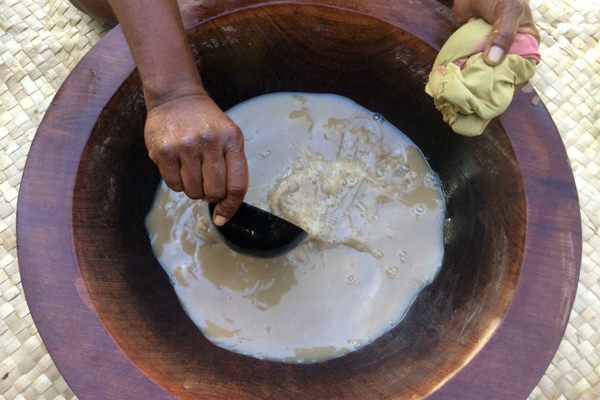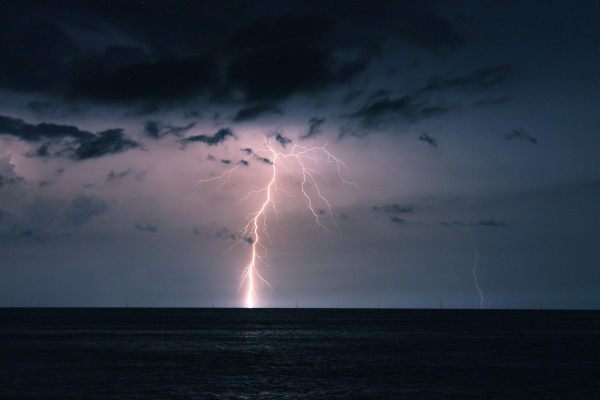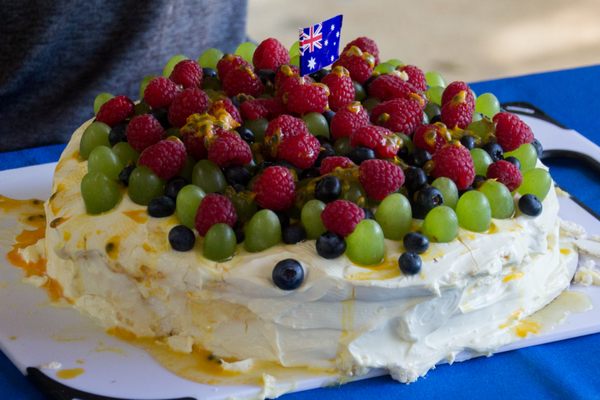
The Tiny Town Where Corrugated Iron Becomes Building-Sized Art
In Tirau, New Zealand, a classic construction material takes on a life of its own.
Steven Clothier never intended to become an artist. A mechanic by trade, the New Zealander used to work odd jobs around his home of Tirau, a small township of 800 people whose name means “place of many cabbage trees” in te reo Māori. Today, he’s known for his quirky outdoor sculptures and colorful signs made of corrugated iron, which can be found across the country, especially on the North Island. In Auckland, a smiling strawberry waving a flag marks the entrance to a berry farm. In Putaruru, a hulking meat pie rests atop a bakehouse, its savory innards appearing to spill out.
But it was a giant dog, bright-eyed and floppy-eared, that started it all. Lounging on a street corner in Tirau, the goofy canine is one of the town’s most famous landmarks and has helped earn it the nickname “Corrugated Capital of the World.” An example of mimetic architecture—buildings designed to look like anything that isn’t a building—it houses the town’s information center and public restrooms.
Clothier built the structure in 1998 for the local council, which had solicited design ideas from the community. “We wanted something different because we’re in a little bit of a wacky town,” he says. “My father suggested that we build a corrugated iron dog, and he volunteered me to build it.” The mechanic had never worked with galvanized steel sheets before, but the council commissioned it, and he unveiled his handiwork—a white pooch complete with a lolling tongue—three months later.

For anyone who grew up in sheep country, a dog was a fitting choice for the project. The street corner was already occupied by another mimetic building, a merino wool shop shaped like a sheep; visitors entered through a door tucked beneath the cheerful creature’s chin. The addition of Clothier’s canine helped create a comical scene. It also sparked a demand for similar pieces from other residents.
“Once we had the big sheep and the big dog, the rest of the town sort of got behind it,” Clothier says. After finishing a few commissions for local restaurants and stores, he launched Corrugated Creations, a business dedicated to creating eye-catching artworks out of hardy, weather-resistant corrugated iron. His creations gradually began to dot the country; some made their way across the Tasman Sea to Australia.
Located at a major intersection of two state highways, Tirau is an easy and popular stopover for travelers, who today delight in photographing its outdoor corrugated art, from the big pūkeko birds lounging on a roof to a massive praying mantis hovering over a hydroponics store. Tourists might see these as eccentric roadside attractions, but more than presenting unique photo ops, the structures commemorate a material that has played a significant role in the country’s architectural history. “It does sort of hit home for New Zealanders,” Clothier says of the bent sheet. “Everyone recognizes it as a product that’s part of the landscape.”

British colonizers first exported corrugated iron to the islands in the 19th century. (Although widely identified as iron, the material is neither iron nor tin but technically corrugated steel.) It quickly became—and still remains—a popular and economical option for roofing, protecting homes, churches, barns, and other farm buildings. According to Wrinkly Tin, a brief history of corrugated iron in Aotearoa New Zealand by the late engineer Stuart Thomson, the utilitarian product inspires a sense of nostalgia for many New Zealanders. “Corrugated iron has been used in so many ways in the past that it has become a Kiwi icon, with a historic and aesthetic value we are emotionally attached to,” Thomson writes. “Its dominance has been challenged by a range of more sophisticated materials, but corrugated iron is still No. 1 and quintessentially New Zealand.”
For Clothier, the rippled metal holds all kinds of creative possibilities, whether as sculpture or architecture. In 2015, he embarked on his biggest work yet—an extension of the sheep-shaped wool shop, designed in the form of a ram. The resulting creature, made of nearly 500 feet of corrugated iron, is more detailed than its companions, featuring curved, three-sided horns, rounded tufts of wool, and a yellow ID tag on its ear. “It’s like putting together a jigsaw puzzle, but that’s why I enjoy it,” Clothier says of the building process. “It keeps the mind active.”
Some people have denounced some of his pieces as eyesores, Clothier says. But he believes that the sculptures have helped to place his tiny community on the map. “Tirau was one of those lil’ wee towns that you pass through on the way elsewhere,” Clothier says. “It’s now become its own little destination because people come to actually look at the art. I think it has definitely helped this town.”










Follow us on Twitter to get the latest on the world's hidden wonders.
Like us on Facebook to get the latest on the world's hidden wonders.
Follow us on Twitter Like us on Facebook